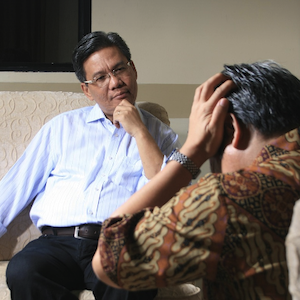A theoretical and clinical perspective of an embodied view in psychotherapy of somatic symptoms disorders

Submitted: December 29, 2021
Accepted: April 26, 2023
Published: August 25, 2023
Accepted: April 26, 2023
Abstract Views: 1478
PDF: 440
HTML: 46
HTML: 46
Publisher's note
All claims expressed in this article are solely those of the authors and do not necessarily represent those of their affiliated organizations, or those of the publisher, the editors and the reviewers. Any product that may be evaluated in this article or claim that may be made by its manufacturer is not guaranteed or endorsed by the publisher.
All claims expressed in this article are solely those of the authors and do not necessarily represent those of their affiliated organizations, or those of the publisher, the editors and the reviewers. Any product that may be evaluated in this article or claim that may be made by its manufacturer is not guaranteed or endorsed by the publisher.
Similar Articles
- Adam Klocek, Tomáš Řiháček, The associations between interoceptive awareness, emotion regulation, acceptance, and well-being in patients receiving multicomponent treatment: a dynamic panel network model , Research in Psychotherapy: Psychopathology, Process and Outcome: Vol. 26 No. 2 (2023)
- Nina Jakhelln Laugen, Torun Grøtte, Truls Ryum, Patrick A. Vogel, Heidi Brattland, Katrine Høyer Holgersen, Something has sort of opened up for me: psychology students’ reflections after participating in an apprenticeship training model , Research in Psychotherapy: Psychopathology, Process and Outcome: Vol. 27 No. 2 (2024)
- Racheli Miller, Mark J. Hilsenroth, Paul L. Hewitt, Perfectionism and therapeutic alliance: a review of the clinical research , Research in Psychotherapy: Psychopathology, Process and Outcome: Vol. 20 No. 1 (2017)
- Vittorio Lingiardi, Nancy McWilliams, Laura Muzi, The contribution of Sidney Blatt's two-polarities model to the Psychodynamic Diagnostic Manual , Research in Psychotherapy: Psychopathology, Process and Outcome: Vol. 20 No. 1 (2017)
- Marta Vecchiato, Chiara Sacchi, Alessandra Simonelli, Nicola Purgato, Evaluating the efficacy of psychodynamic treatment on a single case of autism. A qualitative research , Research in Psychotherapy: Psychopathology, Process and Outcome: Vol. 19 No. 1 (2016): Special issue on Qualitative and Quantitative Research in Child and Adolescent Psychotherapy: part 2
- Ana Marìa Luzzi, Daniela Bardi, Laura Ramos, Sara Slapak, A study of process in psychoanalytic psychotherapy with children: the development of a method , Research in Psychotherapy: Psychopathology, Process and Outcome: Vol. 18 No. 2 (2015): Special issue on Qualitative and Quantitative Research in Child and Adolescent Psychotherapy: part 1
- Mario Fulcheri, Danilo Carrozzino, The clinical consequence of positive mental health in psychotherapy , Research in Psychotherapy: Psychopathology, Process and Outcome: Vol. 20 No. 2 (2017)
- Paolo Migone, The influence of pharmaceutical companies , Research in Psychotherapy: Psychopathology, Process and Outcome: Vol. 20 No. 2 (2017)
- Eunice Barbosa, Maria Amendoeira, Tiago Ferreira, Ana Sofia Teixeira, José Pinto-Gouveia, Joào Salgado, Immersion and distancing across the therapeutic process: relationship to symptoms and emotional arousal , Research in Psychotherapy: Psychopathology, Process and Outcome: Vol. 20 No. 2 (2017)
- Marianna Liotti, Alice Fiorini Bincoletto, Fabiola Bizzi, Marta Tironi, Simone Charpentier Mora, Donatella Cavanna, Guido Giovanardi, Elliot Jurist, Anna Maria Speranza, Vittorio Lingiardi, Annalisa Tanzilli, The catcher in the mind: validation of the brief-mentalized affectivity scale for adolescents in the Italian population , Research in Psychotherapy: Psychopathology, Process and Outcome: Vol. 26 No. 3 (2023)
<< < 4 5 6 7 8 9 10 11 12 13 > >>
You may also start an advanced similarity search for this article.

 https://doi.org/10.4081/ripppo.2023.605
https://doi.org/10.4081/ripppo.2023.605





